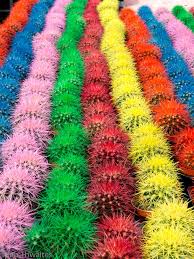 |
| Tillandsia streptocarpa, MRobb, 2015 |
Tillandsias, Mesembs, orchids, herbalism, art, pensive musings, and gardening on sand dunes.
Tuesday, June 30, 2015
Back to the Tillies: Tillandsia streptocarpa
Alert Naturalist Baker named this delightfully fragrant Tillie in 1887. It means "twisted fruit", and that refers to the twisty seed pods. The name should have referred to the delightful perfume this Tillandsia emits when it blooms. The pale lavender flowers smell very much like wisteria and honey. Gorgeous....
T. streptocarpa grows in open woodlands from Peru to Bolivia, Paraguay to Brazil. It can grow at relatively low elevation, up to 2,300m! This is according to expert Paul Isley III, and you can find more info in his book, "Tillandsia II". This Tillie needs a little more light, water, and fertilizer than average in order to grow and bloom well. The blooms last for a month. Fragrant Tillies are unusual so if you get a chance to grow this one, go for it, you won't be disappointed.
Sunday, June 28, 2015
Abominable!
Alert Gardeners Gail and Ellen brought up a horrible new practice at the big box stores. Spray-painted cacti and succulents. If this isn't plant torture (and eye torture) I don't know what is:
I've been reading a book called "Supernormal Stimuli" by Deirdre Barrett. She describes how in our modern techno-paradise (ha!) we keep piling on abnormal stimuli and we get hooked on this. Seems green cacti aren't enough anymore and some bright marketing VP came up with "something better". It sure does draw attention, but it is disgusting.
No idea if it actually kills the plants but I'll bet it doesn't enhance photosynthesis or respiration. Remember Jill Masterson from the James Bond film "Goldfinger"?? 'Nuf said.
Maybe we gardeners should start a "Keep Plants Green" campaign??
I've been reading a book called "Supernormal Stimuli" by Deirdre Barrett. She describes how in our modern techno-paradise (ha!) we keep piling on abnormal stimuli and we get hooked on this. Seems green cacti aren't enough anymore and some bright marketing VP came up with "something better". It sure does draw attention, but it is disgusting.
No idea if it actually kills the plants but I'll bet it doesn't enhance photosynthesis or respiration. Remember Jill Masterson from the James Bond film "Goldfinger"?? 'Nuf said.
Maybe we gardeners should start a "Keep Plants Green" campaign??
Saturday, June 27, 2015
Weekend Walkabout:Sunset Storm Evolution
I promise I'll blog about plants tomorrow (really!) but I had to share the evolution of a storm off the beach today. We have no mountains here- our clouds are mountains.
10 minutes later....
And 5 minutes after that....
And finally, just before dark....
10 minutes later....
And 5 minutes after that....
And finally, just before dark....
Wednesday, June 24, 2015
Orchids: To Stake or Not?
Traditionally, orchids in bloom are staked. This keeps the flowers more or less upright, and the plant from lurching out of its pot. But more and more often, I am seeing orchids bloom in a more natural manner, without their stakes. Which do you prefer? Staked:
Or no stake?
This unstaked phal is taking advantage of its relative freedom by visiting its neighbor. So far it has not fallen out of its pot. I have found that using clay orchid pebbles in the orchid mix makes the pot heavy enough so that the plant does not fall. Most of my orchids bloom without stakes now, but I confess that's because I'm kinda lazy.
I also like the snaky inflorescence of an unstaked orchid, and how they can create some weird curves, or drape themselves downwards or around other things. At our recent orchid show, about a quarter of the orchids on display were unstaked, and several of the top winners were "au natural". Definitely a trend....
 |
| Staked, tall, and straight. |
 |
| Unstaked, snakey, and sideways. |
I also like the snaky inflorescence of an unstaked orchid, and how they can create some weird curves, or drape themselves downwards or around other things. At our recent orchid show, about a quarter of the orchids on display were unstaked, and several of the top winners were "au natural". Definitely a trend....
Friday, June 19, 2015
Weekend Walkabout With Chef Riccardo
My beaches are way too hot for walking this weekend; by mid-morning, the sand scorches my poor bare feet. Not into that! So for the Weekend Walkabout I asked Chef Riccardo, an avid hill walker, what he has been up to in Northern Italy. Here's the photo he sent:
Beautiful! These charming herbivores (Rupicapra rupicapra) of the Alps are called Chamois, or Gams in German, or Camosci in Italian. A fun fact: adult chamois can jump 2m in the air, and 6m in distance. They live in herds of up to 100 individuals, mostly females and young, as shown here. The males tend to a more solitary existence. Some subspecies are now protected in Europe, and that's a good thing. Have a wonderful weekend walkabout in your neck of the woods!
 |
| "Camosci", Riccardo Senettin, 2015 |
Wednesday, June 17, 2015
Time for the Cacti Re-Pot!
Cacti grow very slowly, bloom once a year if at all, and basically, prefer to be left alone.
Nevertheless, it's good to thoroughly re-pot them once every two years. They can keep their old pots, but the soil will be worn out and need replacement. I keep track by re-potting during the summers of odd years.
The necessaries are: plasticised or other very tough gloves; cactus soil, homemade or store-bought, a stick or spoon to help pry out stuck cacti and to tamp in the new soil, and attractive gravel for the top. I also use orchid clay pebbles to line the bottom of the pots, but that's not necessary. So let's start!
I remove the cactus from the pot and knock out the old dirt. You can see the old dirt clinging to the root ball here. If it's not knocked off the roots at least in part, the cactus probably won't grow into the new soil and the repotting is wasted and the cactus won't grow. On the other hand, you don't want to just tear up and remove the roots, either, so go slow and gentle.
I clean its pot, throw out the old soil, and add a thin layer of orchid pebbles, made of clay, to the bottom of the pot. This keeps soil from, well, soiling the shelf where the cactus lives.
Using the thick glove, I hold the cactus upright and fill in the pot with new cactus soil. I've tried about three types of commercial soil and the only one I like is Espoma, which is wonderful. I also make my own. There are all sorts of recipes on the Internet so you can take your pick and experiment.
Once the soil is in, I tamp it down gently and add attractive gravel to the top. This acts as a mulch and looks nice, too. Then I brush off the cactus and pot, and it's ready for the next two years! I don't water them for a few days (some people say up to 10) because of the inevitable root damage during re-potting. The dry days give the damaged roots a chance to heal.
And that's it!
 |
| "Fluffpuff" in bloom, MR |
 |
| The set-up. |
 |
| Cactus out of pot. |
 |
| What's at the bottom. |
 |
| Remember your gloves for this bit! |
Once the soil is in, I tamp it down gently and add attractive gravel to the top. This acts as a mulch and looks nice, too. Then I brush off the cactus and pot, and it's ready for the next two years! I don't water them for a few days (some people say up to 10) because of the inevitable root damage during re-potting. The dry days give the damaged roots a chance to heal.
 |
| Mammillaria with new soil. Ah! |
Wednesday, June 10, 2015
Babytoes Blooms in 2015, Too!
The summer heat is on and Fenestraria, aka Babytoes, is celebrating by...you can guess this...blooming! She starts around dawn and her blooms are in full glory by breakfast time:
Babytoes hails from Namaqualand, Africa, and is grown just like all other mesembs--well-draining, rather poor soil, lots of sun, not too much water. She's been cheering me for years now, and her blooms never cease. Hurray for Babytoes!
Babytoes hails from Namaqualand, Africa, and is grown just like all other mesembs--well-draining, rather poor soil, lots of sun, not too much water. She's been cheering me for years now, and her blooms never cease. Hurray for Babytoes!
Sunday, June 7, 2015
Another Catasetum Close-Up
Friday, June 5, 2015
Close-up of Cat Flowers
Alert Gardener Gail asked if she could see a close-up of the weird blooms of orchid Catasetum tenebrosum. Here you are!
Just to make them even more, um, odd, some Cats will discharge their "superglue" pollen quite violently onto passersby, kind of like the creepy, make-em-all-happy plants in the Star Trek Episode "This Side of Paradise". Sadly, Cat's pollen has no similar apparent effect on Earth mammals. There are about 50 species of Catasetum orchids, all from Central and South America, and the West Indies.
And now, a gratuitous photograph of kayaking in the tropics, ah! This is our local nature preserve.
Just to make them even more, um, odd, some Cats will discharge their "superglue" pollen quite violently onto passersby, kind of like the creepy, make-em-all-happy plants in the Star Trek Episode "This Side of Paradise". Sadly, Cat's pollen has no similar apparent effect on Earth mammals. There are about 50 species of Catasetum orchids, all from Central and South America, and the West Indies.
And now, a gratuitous photograph of kayaking in the tropics, ah! This is our local nature preserve.
Wednesday, June 3, 2015
Catasetum tenebrosum blooms!
Well, it finally happened and my living room smells like blackcurrant, honey, and cat pee. Why? Because that's what the flowers of Catsetum tenebrosum smell like!
This is not an "easy care" orchid, and it looks pretty dreadful most of the year.
That's what makes these few days in early summer so special. When "Cat" finally shows her strange black flowers with the golden centers, everyone is amazed. It's kind of like that grumpy, antisocial person you try to coax into a smile with no success, then one day, she cracks a joke and hugs you. Or something like that.... Anyway, with Cat the joke is off-color, as that cat-pee perfume is definitely less than charming. Still, some plants have their own, off-color charm, don't they?
They're not going to clone this one on an orchid farm in Thailand anytime soon, that's for sure. And that's one of the reasons I love it.
This is not an "easy care" orchid, and it looks pretty dreadful most of the year.
That's what makes these few days in early summer so special. When "Cat" finally shows her strange black flowers with the golden centers, everyone is amazed. It's kind of like that grumpy, antisocial person you try to coax into a smile with no success, then one day, she cracks a joke and hugs you. Or something like that.... Anyway, with Cat the joke is off-color, as that cat-pee perfume is definitely less than charming. Still, some plants have their own, off-color charm, don't they?
 |
| Catasetum tenebrosum in bloom, Marla Robb, June 2015 |
They're not going to clone this one on an orchid farm in Thailand anytime soon, that's for sure. And that's one of the reasons I love it.
Subscribe to:
Comments (Atom)











